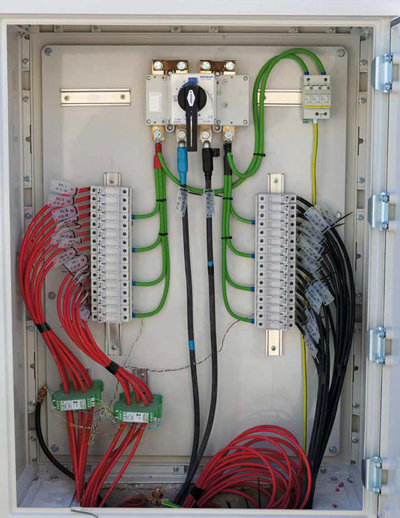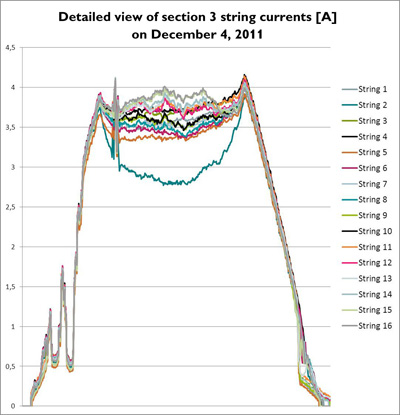String-level Monitoring: An essential tool for reliable PV operation & maintenance
 Reliable operation and efficient maintenance are important contributing factors in the success of photovoltaic (PV) plant installations. As installations grow larger through commercial and into utility scale, PV plants are composed of many thousands of modules, parallel strings, and electrical connections. Beyond the scope of just measuring the AC output of a PV plant via a utility-grade meter, the economics of solar energy require that all plant components contribute to the financial success of the installation.
Reliable operation and efficient maintenance are important contributing factors in the success of photovoltaic (PV) plant installations. As installations grow larger through commercial and into utility scale, PV plants are composed of many thousands of modules, parallel strings, and electrical connections. Beyond the scope of just measuring the AC output of a PV plant via a utility-grade meter, the economics of solar energy require that all plant components contribute to the financial success of the installation.
Solar economics usually dictate that large installations utilize central inverters. There are many faults herein, however, that can contribute to a poor yield from an installation, including: module failures; uneven soiling; zonal shading; premature aging; blown fuses; and poor connections. And, due to parallel string connections, these small yet economically important changes in array performance might not be detectable at the large-value, aggregated DC inverter inputs.
To keep measurement efforts of large-scale PV plants low, high-resolution, DC string-level current measurement at the combiner box can offer a suitable compromise when efficiently evaluating the performance of an array. Using this measurement, in conjunction with an array irradiance sensor, real losses that impact plant yield can be determined. When this system is coupled with a supervisory control and data acquisition (SCADA) system, as well as a data historian, real-time and historical assessments can also be made of array performance. Identification and repair of array defects is one critical element in ensuring the proper rate of return on solar investments.
String-level monitoring performance
The essential performance elements of PV string level monitoring systems are:
• Diagnostics of solar plant faults;
• Validation of solar array performance; and
• Simple and cost-effective installation
From a diagnostics perspective, central inverters usually have only a few DC maximum power point tracking (MPPT) inputs. The large number of parallel strings required to be connected to these MPPT inputs, combined with the typically five percent current measurement accuracy, means that small individual string performance changes cannot accurately be measured by the inverter monitoring system.
For validation purposes, string current measurements are evaluated along with array irradiance levels. In certain applications, combiner box level DC voltages are also measured. These parameters can be used to form an inverter-independent evaluation of the solar array performance for diagnostic, validation, and economic purposes.
A simple, cost-effective installation is an essential performance element in implementing a string-level PV monitoring system. Current sensors and other components must fit efficiently into the confines of a combiner box. In addition, data must be efficiently shared with SCADA systems.
Implementing the system
 The most common sensors seen in string-level monitoring are shunt-type devices and Hall effect sensors. Shunt-type devices measure current by monitoring the voltage drop over a fixed resistance. These devices require that PV string cabling be interrupted for connection, and insertion resistance loses of 0.1 ohm to 1 ohm are typical. Hall effect sensors measure conductor magnetic flux, generating a signal proportional to the strength and direction of the current flow. Hall effect measurements don’t require interruption of the PV string cable, and have no insertion losses. Voltage isolation is dependent upon the conductor rating—an important consideration with the movement toward nominal array voltages of 1000 VDC and beyond.
The most common sensors seen in string-level monitoring are shunt-type devices and Hall effect sensors. Shunt-type devices measure current by monitoring the voltage drop over a fixed resistance. These devices require that PV string cabling be interrupted for connection, and insertion resistance loses of 0.1 ohm to 1 ohm are typical. Hall effect sensors measure conductor magnetic flux, generating a signal proportional to the strength and direction of the current flow. Hall effect measurements don’t require interruption of the PV string cable, and have no insertion losses. Voltage isolation is dependent upon the conductor rating—an important consideration with the movement toward nominal array voltages of 1000 VDC and beyond.
Serial Modbus RTU has become the de facto stand for combiner box, string-level communications. Connectivity via Modbus is widely available in many SCADA devices. The 1200 m maximum distance of RS 485 Modbus RTU, and the high number of node addresses fit effectively into the topology of large PV installations. Data can be converted to Ethernet Modbus TCP via a device server, usually at a more centralized location. Wireless communication, via Zigbee or other proprietary communications, have also been used. However, most string-level monitoring implementations employ wired communications, which are installed conveniently with array power cabling.
Beyond DC string current and voltage measurement, string-level monitoring devices are most often used to measure combiner box temperatures. Local inputs for the monitoring of surge suppression devices, enclosure door position, as well as weather and irradiance sensors are also seen. Power for the monitoring device is usually 24 V DC, supplied via a DC power supply, which requires that AC power be run to the combiner box. Array-powered DC/DC converters have been used in limited applications. New measuring devices are now also available that combine device power and signal on one cable, eliminating the need for a separate power source at the combiner box level.
From a PV string-level monitoring perspective, one percent nominal DC current sensor accuracy with a 200 mA resolution is considered good performance. As string currents vary with irradiance, data sample rates of under one minute are recommended. These data points can be averaged to provide trend information over longer time periods*.
Detectable plant faults
Under-performing strings represent the most common plant fault characteristic detectable by string-level current monitoring. Unless a significant number of strings under-perform, these faults usually aren’t detectable via inverter DC input monitoring. Common causes of under-performing strings may include PV module failures and poor connectivity.
Other fault characteristics can include:
• Zonal shading & uneven soiling: usually time of day and/or portion of array dependent;
• Blown string fuses and complete connection failures: these might not be caught at the inverter level;
• Premature PV module aging: measured by comparing string performance over time; and
• Cabling short circuits: determined by measuring current flows when an inverter is off.
Maintenance response to these faults is usually dependent upon the number of faults observed, the value of the electrical power generated, and the expected rate of return on plant investment.
Summary
The evaluation of PV plant performance at the string level has become an effective tool in the validation of solar installation performance and the rapid diagnostics of plant faults, lowering operational costs, maximizing solar plant yield, and ensuring the maximum rate of return on solar investments. Undetected faults prevent power production at the lowest levelized cost of energy. Low LCOE over the entire life of an installation is a critical element in attracting solar power investments.
* SunSpec Alliance, Open Solar Performance and Reliability (oSPARC) Implementer’s Guide, Version 1.0.
Daniel J Sylawa is the business development manager for renewable energy at Phoenix Contact Inc.
Phoenix Contact Inc.
www.phoenixcon.com
Author: Daniel J Sylawa
Volume: September/October 2013










.jpg?r=6897)
.jpg?r=2693)
.gif?r=9873)